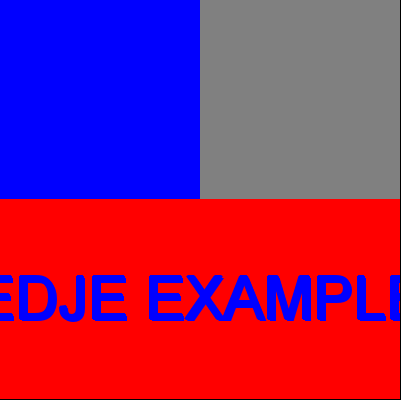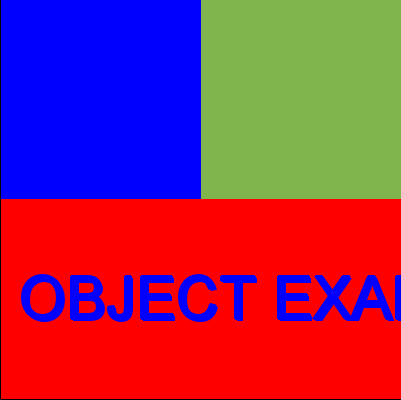This example shows how to manipulate and change Color classes. In this example we will create two surfaces to show what happens when you change the color class at the process and object level.
It's a very simple example, there are two surfaces created from the same EDC, but just in one of them we will set a specific color class, although both will be affected by color class set at the process level as you will see.
It's important you know that all colors has the format R G B A. Just to be easier to understand this example, we will create a small set of colors that will be used along of the example. This piece of code is shown below:
Focusing on the relevant parts of the code we go right to the part where we set the new color class. For that we will use the functions edje_color_class_set ( which will affect all edjes) and edje_object_color_class_set (which affects just the specific object).
After we have set the color class we will check the color classes, for that we created a function which prints all color classes and tries to get theirs values and print too.
_color_classes_print(void)
{
char *class_name;
printf("Getting the color classes\n\n");
{
int r1, r2, r3, g1, g2, g3, b1, b2, b3,
a1, a2, a3;
printf("\ncolor class: %s\n", class_name);
&r2, &g2, &b2, &a2, &r3, &g3, &b3, &a3))
fprintf(stderr, "Cannot get the color class\n");
else
{
printf("Object color r: %d g: %d b: %d a: %d\n",
r1, g1, b1, a1);
printf("Text outline color r: %d g: %d b: %d a: %d\n",
r2, g2, b2, a2);
printf("Text shadow color r: %d g: %d b: %d a: %d\n",
r3, g3, b3, a3);
}
free(class_name);
Eina_List * edje_color_class_list(void)
Lists color classes.
Definition edje_util.c:799
Eina_Bool edje_color_class_get(const char *color_class, int *r, int *g, int *b, int *a, int *r2, int *g2, int *b2, int *a2, int *r3, int *g3, int *b3, int *a3)
Gets Edje color class.
Definition edje_util.c:750
#define EINA_LIST_FREE(list, data)
Definition for the macro to remove each list node while having access to each node's data.
Definition eina_list.h:1629
Type for a generic double linked list.
Definition eina_list.h:318
}
}
There are two other things that are worth mentioning, we added two callbacks for the objects, one for mouse down (that we use to delete the color class) and another for the signal emitted when a color class is deleted.
Our example will look like this, if you run with the parameters "green_class gray pink yellow":
#ifdef HAVE_CONFIG_H
# include "config.h"
#else
# define EINA_UNUSED
#endif
#ifndef PACKAGE_DATA_DIR
#define PACKAGE_DATA_DIR "."
#endif
#include <Ecore.h>
#define WIDTH (400)
#define HEIGHT (400)
typedef int color[4];
static Ecore_Evas *ee1, *ee2;
static Evas *evas1, *evas2;
static Evas_Object *bg1, *edje_obj1, *bg2, *edje_obj2;
static const char *selected_class;
static color colors_init_data[] =
{{255, 0, 0, 255},
{0, 255, 0, 255},
{0, 0, 255, 255},
{0, 0, 0, 255},
{255, 255, 255, 255},
{128, 128, 128, 255},
{255, 255, 0, 255},
{255, 0, 255, 255}
};
static char *color_names[] =
{"red", "green", "blue", "black", "white",
"gray", "yellow", "pink"};
_get_color_from_name(const char *n, color *c)
{
int i;
for (i = 0; i < 8; i++)
if (!strcmp(n, color_names[i]))
{
(*c)[0] = (colors_init_data[i])[0];
(*c)[1] = (colors_init_data[i])[1];
(*c)[2] = (colors_init_data[i])[2];
(*c)[3] = (colors_init_data[i])[3];
}
}
static void
_color_classes_print(void)
{
char *class_name;
printf("Getting the color classes\n\n");
{
int r1, r2, r3, g1, g2, g3, b1, b2, b3,
a1, a2, a3;
printf("\ncolor class: %s\n", class_name);
&r2, &g2, &b2, &a2, &r3, &g3, &b3, &a3))
fprintf(stderr, "Cannot get the color class\n");
else
{
printf("Object color r: %d g: %d b: %d a: %d\n",
r1, g1, b1, a1);
printf("Text outline color r: %d g: %d b: %d a: %d\n",
r2, g2, b2, a2);
printf("Text shadow color r: %d g: %d b: %d a: %d\n",
r3, g3, b3, a3);
}
free(class_name);
}
}
static void
{
}
static void
{
{
if (obj == edje_obj1)
else
}
}
static void
_canvas_resize_cb(Ecore_Evas *_ee)
{
int w, h;
if (_ee == ee1)
{
}
else
{
}
}
static void
_color_class_callback_delete(
void *data, Evas_Object *obj
EINA_UNUSED,
{
if (!strcmp(data, "process"))
printf("Color class: %s deleted on process level\n", emission);
else
printf("Color class: %s deleted on object level\n", emission);
}
static int
_create_windows(const char *edje_file_path)
{
if (!ee1)
return 0;
if (!ee2)
return 0;
_on_mouse_down, NULL);
(Edje_Signal_Cb) _color_class_callback_delete,
"process");
_on_mouse_down, NULL);
(Edje_Signal_Cb) _color_class_callback_delete,
"object");
return 1;
}
int
main(int argc, char *argv[])
{
const char *edje_file = PACKAGE_DATA_DIR"/color-class.edj";
color c1, c2, c3;
int i;
if (argc != 5)
{
fprintf(stderr, "You have to use: %s color_class_name color1, color2," \
"color3\n", argv[0]);
fprintf(stderr, "Available colors:\n");
for (i = 0; i < 8; i++)
fprintf(stderr, "%s\n", color_names[i]);
return EXIT_FAILURE;
}
selected_class = argv[1];
if (!(_get_color_from_name(argv[2], &c1) &&
_get_color_from_name(argv[3], &c2) &&
_get_color_from_name(argv[4], &c3)))
{
fprintf(stderr, "Color not available!\n");
return EXIT_FAILURE;
}
return EXIT_FAILURE;
goto shutdown_ecore_evas;
if (!_create_windows(edje_file)) goto shutdown_edje;
c1[0], c1[1], c1[2], c1[3],
c2[0], c2[1], c2[2], c2[3],
c3[0], c3[1], c3[2], c3[3]);
128, 180, 77, 255,
200, 22, 86, 255,
39, 90, 187, 255);
_color_classes_print();
return EXIT_SUCCESS;
shutdown_edje:
shutdown_ecore_evas:
return EXIT_FAILURE;
}
Edje Graphical Design Library.
EAPI int ecore_evas_init(void)
Inits the Ecore_Evas system.
Definition ecore_evas.c:608
EAPI void ecore_evas_callback_destroy_set(Ecore_Evas *ee, Ecore_Evas_Event_Cb func)
Sets a callback for Ecore_Evas destroy events.
Definition ecore_evas.c:1199
EAPI void ecore_evas_title_set(Ecore_Evas *ee, const char *t)
Sets the title of an Ecore_Evas' window.
Definition ecore_evas.c:1541
EAPI void ecore_evas_show(Ecore_Evas *ee)
Shows an Ecore_Evas' window.
Definition ecore_evas.c:1494
EAPI Evas * ecore_evas_get(const Ecore_Evas *ee)
Gets an Ecore_Evas's Evas.
Definition ecore_evas.c:1314
EAPI void ecore_evas_geometry_get(const Ecore_Evas *ee, int *x, int *y, int *w, int *h)
Gets the geometry of an Ecore_Evas.
Definition ecore_evas.c:1376
EAPI Ecore_Evas * ecore_evas_new(const char *engine_name, int x, int y, int w, int h, const char *extra_options)
Creates a new Ecore_Evas based on engine name and common parameters.
Definition ecore_evas.c:1053
EAPI void ecore_evas_callback_resize_set(Ecore_Evas *ee, Ecore_Evas_Event_Cb func)
Sets a callback for Ecore_Evas resize events.
Definition ecore_evas.c:1154
EAPI int ecore_evas_shutdown(void)
Shuts down the Ecore_Evas system.
Definition ecore_evas.c:672
EAPI void ecore_evas_free(Ecore_Evas *ee)
Frees an Ecore_Evas.
Definition ecore_evas.c:1097
void ecore_main_loop_quit(void)
Quits the main loop once all the events currently on the queue have been processed.
Definition ecore_main.c:1321
void ecore_main_loop_begin(void)
Runs the application main loop.
Definition ecore_main.c:1311
int edje_shutdown(void)
Shuts down the Edje library.
Definition edje_main.c:262
int edje_init(void)
Initializes the Edje library.
Definition edje_main.c:35
Evas_Object * edje_object_add(Evas *evas)
Instantiates a new Edje object.
Definition edje_smart.c:22
Eina_Bool edje_object_file_set(Evas_Object *obj, const char *file, const char *group)
Sets the EDJ file (and group within it) to load an Edje object's contents from.
Definition edje_smart.c:467
Eina_Bool edje_object_part_text_set(const Evas_Object *obj, const char *part, const char *text)
Sets a given text to an Edje object TEXT or TEXTBLOCK parts.
Definition edje_util.c:6723
EVAS_API void evas_object_show(Evas_Object *eo_obj)
Makes the given Evas object visible.
Definition evas_object_main.c:1814
EVAS_API void evas_object_color_set(Evas_Object *obj, int r, int g, int b, int a)
Sets the general/main color of the given Evas object to the given one.
Definition evas_object_main.c:2024
EVAS_API void evas_object_move(Evas_Object *obj, Evas_Coord x, Evas_Coord y)
Move the given Evas object to the given location inside its canvas' viewport.
Definition evas_object_main.c:1171
EVAS_API void evas_object_resize(Evas_Object *obj, Evas_Coord w, Evas_Coord h)
Changes the size of the given Evas object.
Definition evas_object_main.c:1236
EVAS_API Evas_Object * evas_object_rectangle_add(Evas *e)
Adds a rectangle to the given evas.
Definition evas_object_rectangle.c:78

